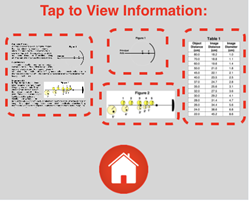About Concave Mirrors
Highly Recommended

Like all our Science Reasoning Center activities, the completion of the Concave Mirrors activity requires that a student use provided information about a phenomenon, experiment, or data presentation to answer questions. This information is accessible by tapping on the small thumbnails found on the bottom right of every question. However, it may be considerably easier to have a printed copy of this information or to display the information in a separate browser window. You can access this information from
this page.
The Standards
The Concave Mirrors activity describes a collection of experiments in which students investigate the characteristics of images formed by a concave mirror. Information is presented in the form of two diagrams and a data table. Questions target a student's ability to analyze and interpret a complex diagram, to identify the effect of variations in one quantity upon another quantity, to draw conclusions that are supported by one or more data presentations, to identify evidence that supports a conclusion, to transform data from a table into a graph, and to interpolate and extrapolate from data in a table.
Success with the activity requires some degree of proficiency with respect to ...
- Developing and Using Models (Science and Engineering Practice 2.6)
Develop and/or use a model (including mathematical and computational) to generate data to support explanations, predict phenomena, analyze systems, and/or solve problems.
- Analyzing and Interpreting Data (Science and Engineering Practice 4.6)
Analyze data to identify design features or characteristics of the components of a proposed process or system to optimize it relative to criteria for success.
- Patterns (Crosscutting Concept 1.2)
Empirical evidence is needed to identify patterns.
- Cause and Effect (Crosscutting Concept 2.2)
Systems can be designed to cause a desired effect.
While the Concave Mirrors activity addresses the two NextGen Science and Engineering Practices and the two Crosscutting Concepts above, the activity drew its greatest inspiration from
ACT's College Readiness Standards for Science Reasoning. The activity consists of 52 questions organized into 13 Question Groups that are spread across the three difficulty levels. All three strands (Interpretation of Data - IOD; Science Investigation - SIN; and Evaluation of Models, Inferences, and Experimental Results - EMI) of the College Readiness Standards are addressed in this activity. The code given for the standard includes three letters to indicate the strand and three numbers to indicate the specific standard within that strand. Higher numbers are indicative of more complex science reasoning skills. The relationship between the questions and the standards is as follows:
Complementary and Similar Resources
The following resources at The Physics Classroom website complement the Concave Mirrors Science Reasoning Activity. Teachers may find them useful for supporting students and/or as components of lesson plans and unit plans.
Physics Classroom Tutorial, Reflection and the Ray Model of Light Chapter: Lesson 3
Physics Video Tutorial, Reflection and Mirrors: Concave Mirror Images
Physics Interactives, Reflection and Mirrors: Optics Bench Simulation
Physics Interactives, Reflection and Mirrors: Name That Image
Physics Interactives, Reflection and Mirrors: Concave Mirror Image Formation
Concept Builders, Reflection and Refraction: The L•O•S•T Art of Image Description
Minds On Physics, Reflection and Mirrors Module, Mission RM6: Concave Mirror Images
The Calculator Pad, Reflection and Mirrors, Problem Sets RM4 - RM8